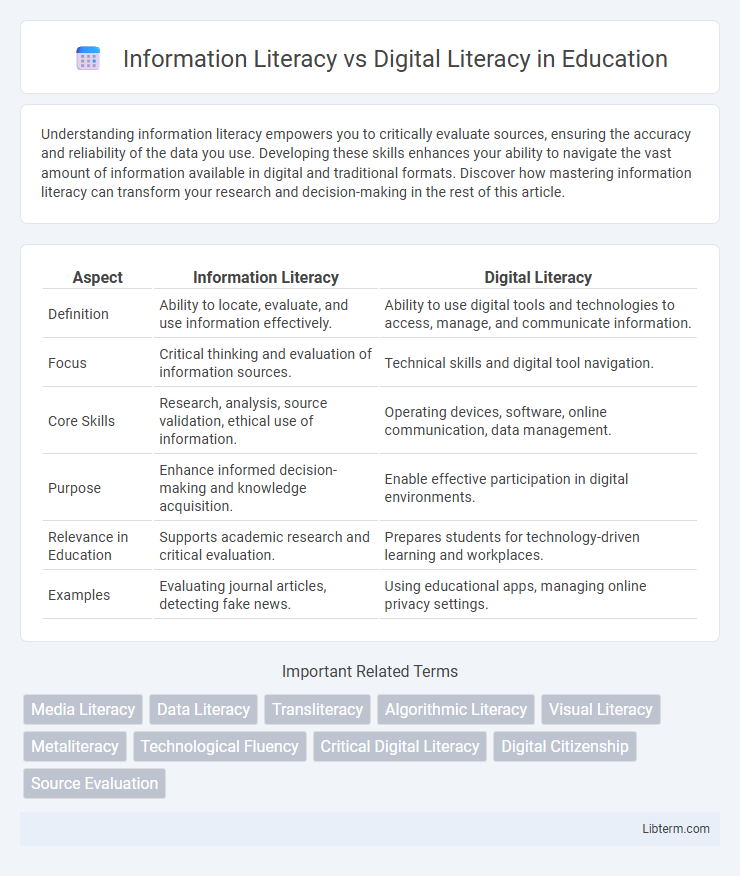Understanding information literacy empowers you to critically evaluate sources, ensuring the accuracy and reliability of the data you use. Developing these skills enhances your ability to navigate the vast amount of information available in digital and traditional formats. Discover how mastering information literacy can transform your research and decision-making in the rest of this article.
Table of Comparison
| Aspect | Information Literacy | Digital Literacy |
|---|---|---|
| Definition | Ability to locate, evaluate, and use information effectively. | Ability to use digital tools and technologies to access, manage, and communicate information. |
| Focus | Critical thinking and evaluation of information sources. | Technical skills and digital tool navigation. |
| Core Skills | Research, analysis, source validation, ethical use of information. | Operating devices, software, online communication, data management. |
| Purpose | Enhance informed decision-making and knowledge acquisition. | Enable effective participation in digital environments. |
| Relevance in Education | Supports academic research and critical evaluation. | Prepares students for technology-driven learning and workplaces. |
| Examples | Evaluating journal articles, detecting fake news. | Using educational apps, managing online privacy settings. |
Understanding Information Literacy: Definition and Scope
Information literacy encompasses the ability to recognize when information is needed and to locate, evaluate, and effectively use that information. It involves critical thinking skills to assess the credibility, relevance, and bias of sources across various formats, including print and digital media. Understanding its scope extends to navigating ethical use and intellectual property considerations while fostering lifelong learning and informed decision-making.
What is Digital Literacy? Key Concepts and Features
Digital literacy encompasses the ability to effectively use digital tools, platforms, and technologies to access, evaluate, create, and communicate information. Key concepts include understanding online safety, digital ethics, information management, and critical thinking skills related to digital content. Features of digital literacy also involve navigating social media, protecting personal data, and adapting to emerging technologies in various digital environments.
Core Skills Differentiating Information and Digital Literacy
Information literacy centers on the ability to critically evaluate, locate, and use information effectively across various formats, emphasizing skills like source verification, data interpretation, and ethical use of information. Digital literacy primarily involves proficiency with digital tools, including navigating software, understanding digital communication, and managing online security and privacy. Key differentiators include information literacy's focus on critical thinking and content evaluation, contrasting with digital literacy's emphasis on technical skills and digital environment navigation.
Information Literacy in the Digital Age
Information literacy in the digital age involves the ability to locate, evaluate, and effectively use digital information from diverse online sources. It emphasizes critical thinking skills to discern credible content amidst vast internet data, including social media, websites, and digital libraries. Mastery of information literacy ensures individuals can navigate digital environments responsibly, avoiding misinformation and making informed decisions.
Digital Literacy: Beyond Technical Proficiency
Digital literacy extends beyond basic technical skills to include critical thinking, effective communication, and ethical use of digital resources. It encompasses the ability to analyze, evaluate, and create digital content while understanding online safety, privacy, and digital rights. Mastery in digital literacy empowers users to navigate the digital landscape responsibly and participate fully in the information society.
Evaluating Sources: Information Literacy vs. Digital Literacy
Evaluating sources in information literacy involves critically assessing the credibility, relevance, and bias of traditional and digital content to ensure accurate knowledge acquisition. Digital literacy emphasizes navigating online platforms, understanding algorithms, and identifying misinformation or fake news through fact-checking tools and digital verification techniques. Mastery of both literacies enables individuals to discern trustworthy information amidst the vast digital landscape effectively.
Integration of Information and Digital Literacies in Education
Integrating information literacy and digital literacy in education enhances students' ability to critically evaluate sources and effectively use digital tools for research and communication. This combined approach develops skills in information retrieval, ethical use, and digital content creation, fostering comprehensive competence in navigating complex information environments. Educational frameworks increasingly prioritize this integration to prepare learners for the demands of the digital age and knowledge economy.
Challenges in Developing Information and Digital Literacy
Developing information literacy faces challenges such as identifying credible sources amid vast data, understanding information bias, and critically evaluating content relevance. Digital literacy development struggles with rapid technology advancements, varying levels of user access to digital tools, and the need for skills in online security and privacy protection. Both literacies require continuous learning to adapt to evolving information environments and digital platforms, posing ongoing educational and resource allocation challenges.
The Role of Libraries and Educators in Promoting Literacies
Libraries and educators play a pivotal role in advancing both information literacy and digital literacy by providing access to reliable resources and teaching critical evaluation skills. They design instructional programs that empower individuals to discern credible information sources and effectively utilize digital tools for research and communication. These efforts ensure that learners develop competencies necessary for navigating the complex information landscape in academic, professional, and daily contexts.
Future Trends: Convergence of Information and Digital Literacy
Future trends indicate a growing convergence between information literacy and digital literacy as both become essential for navigating an increasingly complex information landscape. Emerging technologies such as artificial intelligence and big data analytics demand skills that integrate critical evaluation of information sources with digital tool proficiency. This convergence fosters a holistic literacy framework, enabling individuals to effectively access, analyze, and apply information in diverse digital environments.
Information Literacy Infographic

 libterm.com
libterm.com